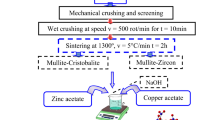Abstract
A wet method technique was used to prepare nano wollastonite ceramic material doped with 5 % CuO. The gel was fired up to 550 °C. The powder was examined using XRD, HRTEM and SEM supplemented with EDAX. X-ray diffraction analysis (XRD) showed the development of quartz, wollastonite and olivine with/without tenorite. The antibacterial and antifungal activity of the particles was estimated by the zone of the inhibition method. It confirmed that the addition of CuO to wollastonite enriches the inhibitory action against all the tested strains, but the growth of the inhibition zone was found to be more significant against gram-negative bacteria (Pseudomonas aeruginosa). Therefore, the Cu ions might have interacted with the bacterial membrane by initiating mechanical damage to their membrane.




Similar content being viewed by others
References
Usman, M.S., El Zowalaty, M.E., Shameli, K., Zainuddin, N., Salama, M., Ibrahim, N.A.: Synthesis, characterization, and antimicrobial properties of copper nanoparticles, Int. J. Nanomedicine 8 (2013) 4467–4479
Ramsden, J.J.: Applied Nanotechnology. Chapter 17: Global nanotechnology (2018) 245–254, eBook, ISBN: 9780128133446
Dziadek, M., Stodolak-Zych, E., Cholewa-Kowalska, K.: Biodegradable ceramic-polymer composites for biomedical applications: A review. Mater. Sci. and Eng. C 71 (2017) 1175–1191
Chatterjee, A.K., Sarkar, R.K., Chattopadhyay, A.P., Aich, P., Chakraborty, R., Basu, T.: A simple robust method for synthesis of metallic copper nanoparticles of high antibacterial potency against E. coli. Nanotechnology 23 (2012) 1–11
Wu, C., Zhou, Y., Xu, M., Han, P., Chen, L., Chang, J., Xiao, Y.: Copper-containing mesoporous bioactive glass scaffolds with multifunctional properties of angiogenesis capacity, osteostimulation and antibacterial activity. Biomater. 34 (2013) 422–433
Sopcak, T., Medvecky, L., Giretova, M., Stulajterova, R., Durisin, J., Girman, V., Faberova, M.: Effect of phase composition of calcium silicate phosphate component on properties of brushite based composite cements. Mater. Character. 117 (2016) 17–29
Wu, B.C., Wei, C.K., Hsueh, N.S., Ding, S.J.: Comparative cell attachment, cytotoxicity and antibacterial activity of radiopaque dicalcium silicate cement and white-coloured mineral trioxide aggregate. Int. Endod. J. 48 (2015) 268–276
Ho, C.-C., Wei, C.K., Lin. S.-Y. Ding, S.J.: Calcium silicate cements prepared by hydrothermal synthesis for bone repair Ceramics International 42 (2016) 9183–9189
Viet, P.V., Nguyen, H.T., Cao, T.M., Hieu, L.V.: Fusarium antifungal activities of copper nanoparticles synthesized by a chemical reduction method. J. Nanomater. 2016 (2016), Article ID 1957612, 1–7, http://dx.doi.org/10.1155/2016/1957612
Burghardt, I., Lüthen, F., Prinz, C., Kreikemeyer, B., Zietz, C., Neumann, H.G., Rychly, J.: A dual function of copper in designing regenerative implants. Biomater. 44 (2015) 36–44
Kalaivani, S., Singh, R.K., Ganesan, V., Kannan, S.: Effect of copper (Cu2+) inclusion on the bioactivity and antibacterial behaviour of calcium silicate coatings on titanium metal. J. Mater. Chem. B 2 (2014) 846–858
Khan, A., Rashid, A., Younas, R., Chong, R.: A chemical reduction approach to the synthesis of copper nanoparticles. Inter. Nano Lett. 6 (2016) [1] 21–26
Paszkiewicz, M., Gołąbiewska, A., Rajski, L., Kowal, E., Sajdak, A., Zaleska-Medynska, A.: The antibacterial and antifungal textile properties functionalized by bimetallic nanoparticles of Ag/Cu with different structures. J. Nanomaterials (2016), Article ID 6056980, 1–13 http://dx.doi.org/10.1155/2016/6056980
Azeena, S., Subhapradha, N., Selvamurugan, N., Narayan, S., Srinivasan, N., Murugesan, R., Chung, T.W., Moorthi, A.: Antibacterial activity of agricultural waste derived wollastonite doped with copper for bone tissue engineering. Mater. Sc. and Eng. C 71 (2017) 1156–1165
Author information
Authors and Affiliations
Corresponding author
Rights and permissions
About this article
Cite this article
Hamzawy, E., Kenawy, S., Abd El Aty, A. et al. Characterization of Wollastonite-Copper Nanoparticles Synthesized by a Wet Method. Interceram. - Int. Ceram. Rev. 67, 20–23 (2018). https://doi.org/10.1007/s42411-018-0010-7
Published:
Issue Date:
DOI: https://doi.org/10.1007/s42411-018-0010-7




